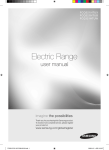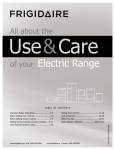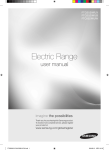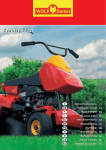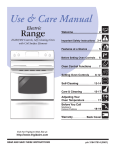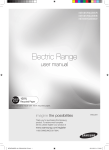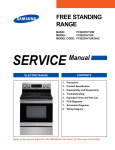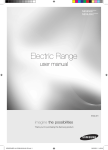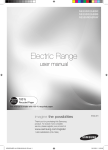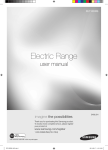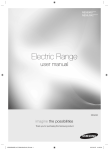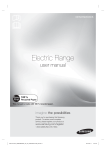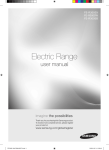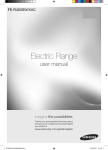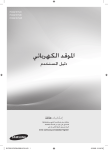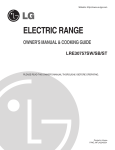Download Samsung FCQ321HTUX User Manual
Transcript
FCQ321HTUX FCQ321HTUB FCQ321HTUW Electric Range user manual imagine the possibilities Thank you for purchasing this Samsung product. To receive more complete service, please register your product at www.samsung.com/global/register FCQ321HTUX_ZAM DG68-00173A.indd 1 2008-06-13 ¿ÀÈÄ 1:41:43 features of your new range Enhanced convenience. Better cooking. Easy maintenance. Your new electric range has been designed to bring you these benefits and more. • Steam Quick cleaning Thanks to Steam Quick™, Samsung’s unique technology for light-duty cleaning jobs, keeping your oven spick-and-span is a snap — no hassle, no odor, no chemicals. Steam Quick™ cleans the inside of your range with high-temperature steam in just 20 minutes. • Bigger is better With a capacity of 5.7 cubic feet, your new range is equipped with more space than any of its competitors in the U.S. market. This means greater convenience for you when cooking for the holidays or when entertaining. • A cooktop with 5 burners Four main burners with one that dial heat up to different pot sizes. A smaller warming burner in the center of the range top. FCQ321HTUX_ZAM DG68-00173A.indd 2 2008-06-13 ¿ÀÈÄ 1:41:44 important safety instructions Read and follow all instructions before using your oven to prevent the risk of fire, electric shock, personal injury, or damage when using the range. This guide does not cover all possible conditions that may occur. Always contact your service agent or manufacturer about problems that you do not understand. SAFETY SYMBOLS WARNING: This symbol alerts you to hazards or unsafe practices that could cause serious bodily harm or death. CAUTION: This symbol alerts you to hazards or unsafe practices that could cause bodily injury or property damage. Do not attempt or use. Do not disassemble. Do not touch. Follow directions explicity. Unplug the power plug from the wall socket. Make sure the machine is grounded to prevent electric shock. Call the service center for help. Note ANTI-TIP DEVICE WARNING-To reduce the risk of tipping the range, the range must be secured by a properly installed Anti-Tip device. Refer to the installation manual for instructions. WARNING ALL RANGES CAN TIP AND CAUSE INJURIES TO PERSONS INSTALL THE ANTI-TIP DEVICE PACKED WITH RANGE FOLLOW ALL INSTALLATION INSTRUCTIONS Do not step, lean, or sit on the doors of the range. These can cause the range to tip, resulting in burns or serious injuries. Check to see that the Anti-Tip device is installed properly. Then grasp the top rear edge of the range and carefully attempt to tilt it forward. Verify that the Anti-Tip device is engaged. If you pull the range out from the wall for any reason, make sure the device is properly engaged when you push the range back against the wall. If it is not, there is a possible risk of the range tipping over and causing injury if you or a child stand, sit or lean on an open door. Important safety instructions _ FCQ321HTUX_ZAM DG68-00173A.indd 3 2008-06-13 ¿ÀÈÄ 1:41:44 FOR YOUR SAFETY When using electrical appliances, basic safety precautions should be followed, including the following: Use this appliance only for its intended purpose as described in this Owner’s Manual. Potentially hot surfaces include the cooktop, areas facing the cooktop, oven vent opening, surfaces near the opening, crevices around the oven door. Be sure your appliance is properly installed and grounded by a qualified technician. User Servicing - Do not repair or replace any part of the appliance unless specifically recommended in the manual. All other servicing should be referred to a qualified technician. Always disconnect power to appliance before servicing by removing the fuse or switching off the circuit breaker. Do not enter inside the oven. Do not store items of interest to children in cabinets above a range or on the back guard of a range. Children climbing on the range to reach items could be seriously injured. Do not leave children alone. Children should not be left alone or unattended in an area where appliance is in use. They should never be allowed to sit or stand on any part of the appliance. Never use your appliance for warming or heating the room. Do not use water on grease fires. Turn off the oven to avoid spreading the flame. Smother the fire or flame by closing the door or use dry chemical, baking soda, or foam-type extinguisher. Storage in or on appliance. Flammable materials should not be stored in an oven or near surface units. Be sure all packing materials are removed from the appliance before operating it. Keep plastics, clothes, and paper away from parts of the appliance that may become hot. Wear proper apparel. Loose-fitting or hanging garments should never be worn while using the appliance. Use only dry potholders. Moist or damp potholders on hot surfaces may result in burns from steam. Do not let the potholder touch hot heating elements. Do not use a towel or other bulky cloth. Teach children not to play with the controls or any other part of the range. _ Important safety instructions FCQ321HTUX_ZAM DG68-00173A.indd 4 2008-06-13 ¿ÀÈÄ 1:41:44 • This appliance must be connected to the mains power supply only by a specially licensed electrician. • In the event of a fault or damage to the appliance, do not attempt to operate it. • Repairs should be performed by a licensed technician only. Improper repair may result in considerable danger to you and others. If your oven needs repair, contact a SAMSUNG Service Centre or your dealer. • If the supply cord is defective, it must be replaced by a special cord or assembly available from the manufacturer or an authorised service agent. • Electrical leads and cables should not be allowed to touch the oven. • The oven should be connected to the mains power supply by means of an approved circuit breaker or fuse. • The rating plate is located above the drawer on the oven frame. • The power supply of the appliance should be turned off when it is being repaired or cleaned. • This appliance is not intended for use by persons (including children) with reduced physical, sensory or mental capabilities, or lack of experience and knowledge, unless they have been given supervision or instruction concerning use of the appliance by a person responsible for their safety. • If the range is placed on a base, measures have to be taken to prevent the appliance slipping from the base. • For your safety, do not use high-pressure water cleaners or steam jet cleaners. Child safety This appliance is not intended for use by young children or infirm persons without the adequate supervision of a responsible adult. Young children should be supervised to ensure that they do not play with the appliance. The cooking zones will become hot when you cook. Always keep small children away from the appliance. WARNING-Accessible parts may become hot during use. To avoid burns young children should be kept away. WARNING-The appliance should be powered down before replacing the lamp to avoid the possibility of electric shock. During oven operation, the interior surfaces become very hot. Important safety instructions _ FCQ321HTUX_ZAM DG68-00173A.indd 5 2008-06-13 ¿ÀÈÄ 1:41:44 SURFACE COOKING UNITS Never leave surface units unattended at high heat settings. Boilovers cause smoking and greasy spillovers that may ignite. Do not lift the cooktop. Lifting the cooktop can lead to damage and improper operation of the range. Do not operate the cooktop when there is no cookware. If the cooktop operates without a cookware, the control knob will become hot. Never use the glass cooktop surface as a cutting board. Use care when touching the cooktop. The glass surface of the cooktop will retain heat after the controls have been turned off. Be careful when placing spoons or other stirring utensils on glass cooktop surface when it is in use. They may become hot and could cause burns. Use proper pan sizes. This appliance is equipped with surface units of different size. Select utensils having flat bottoms large enough to cover the surface unit heating element. The use of undersized utensils will expose a portion of the heating element to direct contact and may result in ignition of clothing. Proper relationship of utensil to burner will also improve efficiency. Glazed cooking utensils. Only certain types of glass, glass/ceramic, ceramic,earthenware, or other glazed utensils are suitable for range-top service without breaking due to the sudden change in temperature. Utensil handles should be turned inward and not extend over adjacent surface units. To reduce the risk of burns, ignition of flammable materials, and spillage due to unintentional contact with the utensil, the handle of a utensil should be positioned so that it is turned inward, and does not extend over adjacent surface units. • Read and follow all instructions and warnings on the cleaning cream labels. • Be sure you know which control knob operates each surface unit. Make sure you turned on the correct surface unit. • Always turn the surface units off before removing cookware. • When preparing flaming foods under the hood, turn the fan on. • Keep an eye on foods being fried at high or medium high heat settings. • If your appliance malfunctions or if fractures, cracks or splits appear: - switch off all cooking zones; - disconnect the hob from the mains supply and contact your local service centre. • If the hob cracks, turn the appliance off to avoid the possibility of electric shock. Do no use your hob until the glass surface has been replaced. • Do not use the hob to heat aluminium foil, products wrapped in aluminium foil or frozen foods packaged in aluminium cookware. • This appliance is to be used only for normal cooking and frying in the home. It is not designed for commercial or industrial use. • Never use the hob for heating the room. • Overheated fat and oil can catch fire quickly. Never leave surface units unattended when preparing foods in fat or oil, for example, when cooking chips. • Never place combustible items on the hob. It may cause fire. • For safety reasons do not clean the appliance with a steam jet or high - pressure cleaner. • Clean the hob in accordance with the cleaning and care instructions contained in this manual. • Any spillage should be removed from the lid before opening and the hob surface should be allowed to cool before closing the lid. _ Important safety instructions FCQ321HTUX_ZAM DG68-00173A.indd 6 2008-06-13 ¿ÀÈÄ 1:41:44 OVEN DO NOT TOUCH HEATING ELEMENTS OR INTERIOR SURFACES OF THE OVEN. Heating elements may be hot even though they are dark in color. Interior surfaces of an oven become hot enough to cause burns. During and after use, do not touch or let clothing or other flammable materials contact heating elements or interior surfaces of oven until they have had sufficient time to cool. Other surfaces of the appliance may become hot enough to cause burns. Among these surfaces are oven vent openings and surfaces near these openings, oven doors, and windows of oven doors. Do not heat unopened food containers. Build-up of pressure may cause container to burst and result in injury. Do not use the oven to dry newspapers. If overheated, they can catch on fire. Do not use the oven for a storage area. Items stored in an oven can ignite. Use care when opening door. Let hot air or steam escape before you remove or replace food in the oven. Protective liners. Do not use aluminum foil to line the oven bottoms, except as suggested in the manual. Improper installation of these liners may result in a risk of electric shock or fire. Keep oven vent ducts unobstructed. The oven vent is located above the right rear surface unit. this area could become hot during oven use. Never block this vent and never place plastic or heat-sensitive items on vent Placement of oven racks. Always place oven racks in the desired location while the oven is cool. If the rack must be moved while oven is hot, do not let the potholder come in contact with the hot heating element in the oven. This oven has been designed only for the cooking of household foods. During use, the oven interior surfaces become hot enough to cause burns. Do not touch heating elements or interior surfaces of the oven until they have had time to cool. Never store flammable materials in the oven. The oven surfaces become hot when the appliance is operated at a high temperature for an extended period of time. Children should be kept at a safe distance when the oven is in use. Do not pour water into the oven bottom when it is hot. This could cause damage to the enamel surface. The oven door must be closed during cooking. Take care when opening the door before the end of the steam cleaning procedure; the water on the bottom is hot. Fruit juices will leave stains, which can become indelible on the enamel surfaces of the oven. When cooking very moist cakes, use the deep pan. Do not rest bakeware on the open oven door. Do not allow aluminum foil or meat probe to contact heating elements. Important safety instructions _ FCQ321HTUX_ZAM DG68-00173A.indd 7 2008-06-13 ¿ÀÈÄ 1:41:44 SELF-CLEANING OVENS Do not clean door gasket. The door gasket is essential for a good seal. Care should be taken not to rub, damage, or move the gasket. Never keep pet birds in the kitchen. The health of birds is extremely sensitive to the fumes released during an oven self-clean cycle. Fumes may be harmful or fatal to birds. Move birds to a well-ventilated room. Clean in the self-clean cycle only parts listed in this manual. Before self-clean the oven, remove the broil pan , rack, utensils, and food. No commercial oven cleaner or oven liner protective coating of any kind should be used in or on the outside of the oven. Use only a ceramic cooktop cleaner or the cleaner supplied with this appliance on the glass cooktop. Nickel oven shelves should be removed from the oven before beginning the self-cleaning cycle, or they may discolor. If the self-clean mode malfunctions, turn the oven off and disconnect the power supply. Have it serviced by a qualified technician. Excess spillage should be removed before self cleaning and all utensils should not be left in the oven during pyrolytic self cleaning. During self cleaning the surfaces get hotter than usual and children should be kept a safe distance. _ Important safety instructions FCQ321HTUX_ZAM DG68-00173A.indd 8 2008-06-13 ¿ÀÈÄ 1:41:44 VENTILATING HOOD Clean ventilating hoods frequently. Grease should not be allowed to accumulate on the hood or filter. When flaming foods under the hood, turn the fan on. GLASS/CERAMIC COOKING SURFACES DO NOT TOUCH SURFACE UNITS OR AREAS NEAR UNITS. Surface units may be hot even though they are dark in color. Areas near surface units may become hot enough to cause burns. During and after use, do not touch, or let clothing or other flammable materials contact surface units or areas near units until they have had sufficient time to cool. Among these areas are the cook-top and facing the cook-top. Do not cook on broken cooktop. If cooktop should break, cleaning solutions and spillovers may penetrate the broken cook-top and create a risk of electric shock. Contact a qualified technician immediately. Clean cooktop with caution. If a wet sponge or cloth is used to wipe spills on a hot cooking area, be careful to avoid steam burn. Some cleaners can produce noxious fumes if applied to a hot surface. before you begin Clean the oven thoroughly before using for the first time. Remove accessories and operate the oven at the bake setting at 400°F for 1 hour before using. There will be a distinctive odor; this is normal, but ensure your kitchen is well ventilated during this conditioning period. Disposal Instructions Disposing of the packaging material • The material used to package this appliance is recyclable. • Dispose of the packaging materials in the appropriate container at your local waste disposal facility. Disposing of old appliances WARNING-Before disposing of old appliances, make them inoperable so that they cannot be a source of danger. To do this, disconnect the appliance from the mains supply and remove the mains lead. To protect the environment, it is important that old appliances are disposed of in the correctmanner. • The appliance must not be disposed of with household rubbish. • You can obtain information about collection dates and public refuse disposal sites from your local refuse department or council. Important safety instructions _ FCQ321HTUX_ZAM DG68-00173A.indd 9 2008-06-13 ¿ÀÈÄ 1:41:44 contents introducing your new range 11 11 Overview 11 What’s included with your range surface cooking 12 14 16 16 17 About surface cooking How to set the appliance for surface cooking Using the proper cookware Choosing the proper cookware Protecting the smoothtop surface operating the oven 18 19 20 20 21 22 23 24 25 27 The oven control panel Setting the clock Minimum and maximum settings Setting the kitchen timer Using the oven racks Baking Timed cooking Delay timed cooking Broiling Extra features maintaining your appliance 30 32 33 35 37 38 39 Self-cleaning Steam-cleaning Care and cleaning of the oven Care and cleaning of the glass cooktop Removing and replacing the oven door Removing and replacing the storage drawer Changing the oven light 12 18 30 troubleshooting 40 40 Troubleshooting 10_ Contents FCQ321HTUX_ZAM DG68-00173A.indd 10 2008-06-13 ¿ÀÈÄ 1:41:44 introducing your new range OVERVIEW Surface control knobs See page 13 for more information 01 INTRODUCING Oven control panel See page 18 for more information Glass surface Automatic oven light switch Oven light Self/steam clean latch Oven door Gasket Shelf position WHAT’S INCLUDED WITH YOUR RANGE Wire racks Introducing your new range _11 FCQ321HTUX_ZAM DG68-00173A.indd 11 2008-06-13 ¿ÀÈÄ 1:41:46 surface cooking About surface cooking BEFORE COOKING CAUTION • Do not use the glass cooktop surface as a cutting board. • Do not place or store items that can melt or catch fire on the glass cooktop, even when it is not being used. • Turn the surface units on only after placing the cookware. • Do not store heavy items above the cooktop surface. They could fall and damage it. DURING COOKING CAUTION • Do not place aluminum foil or plastic items such as salt and pepper shakers, spoon holders, or plastic wrappings on the range when it is in use. The hot air from the vent could melt plastics or ignite flammable items. • Make sure the correct surface unit is turned on. • Never cook directly on the glass. Always use cookware. • Always place the pan in the center of the surface unit you are cooking on. • Never leave surface units unattended while using a high heat setting. Boilovers cause smoking and greasy spillovers that may catch on fire. • Turn the surface units off before removing cookware. • Do not use plastic wrap to cover food. Plastic may melt onto the surface and be very difficult to remove. AFTER COOKING CAUTION • Do not touch the surface units until they have cooled down. • The surface may be still be hot and burns may occur if the glass surface is touched before it has cooled down sufficiently. • Immediately clean spills on the cooking area to prevent a tough cleaning chore later. • If cabinet storage is provided directly above the cooking surface, make sure that the items are infrequently used and can be safely stored in an area subjected to heat. Temperatures may be unsafe for items such as volatile liquids, cleaners or aerosol sprays. About the radiant surface elements The temperature rises gradually and evenly. As the temperature rises, the radiant element will glow red. To maintain the selected setting, the element will cycle on and off. The heating element retains enough heat to provide a uniform and consistent heat during the off cycle. For efficient cooking, turn off the element several minutes before cooking is complete. This will allow residual heat to complete the cooking process. Radiant elements have a limiter that allows the element to cycle ON and OFF, even at the HI setting. This helps to prevent damage to the ceramic cooktop. Cycling at the HI setting is normal and can occur if the cookware is too small for the radiant element or if the cookware bottom is not flat. 12_ Surface cooking FCQ321HTUX_ZAM DG68-00173A.indd 12 2008-06-13 ¿ÀÈÄ 1:41:46 Location of the radiant surface elements and controls The radiant control knobs operate the radiant surface elements on the cooktop as shown below. 5 2 1. Single element: Left rear 4 3 02 SURFACE COOKING 1 2. Single element: Right rear . Single element: Left front . Dual element: Right front . Warming center: Center rear Hot surface indicator • Comes on when the unit is turned on or hot to the touch. • Stays on even after the unit is turned off. • Glows until the unit is cooled to approximately 150°F. Cooking areas • The cooking areas on your range are identified by permanent circles on the glass cooking surface. For the most efficient cooking, fit the pan size to the element size. • Pans should not extend more than ½” to 1” beyond the cooking area. • When a control is turned on, a glow can be seen through the glass cooking surface. The element will cycle on and off to maintain the preset heat setting, even at high settings. • For more information on selecting proper types of cookware, refer to the section “Using the proper cookware” on page 14. Surface cooking _1 FCQ321HTUX_ZAM DG68-00173A.indd 13 2008-06-13 ¿ÀÈÄ 1:41:47 How to set the appliance for surface cooking • The surface elements may be hot and burns may occur. Do not touch surface elements until they have cooled down sufficiently. CAUTION • At high or medium-high settings, never leave food unattended. Boilovers cause smoking and greasy spillovers may catch on fire. • Be sure you turn the control knob to OFF when you finish cooking. • The area between the high and off settings, are not appropriate for cooking. Single surface unit control knob (left front, left rear, right rear) 1. Push the knob in. 2. Turn in either direction to the setting you want. • At both the off and high settings, the knob clicks into position. Dual surface unit control knob (right front) The dual surface unit has 2 cooking sizes to select from so you can match the size of the unit to the size of the cookware you are using. 1. Push the knob in. 2. Turn in either direction to the setting you want. • To use the small surface unit, turn the control knob to the small burner (A) settings. • To use the large surface unit, turn the control knob to the large burner (B) settings. When changing from a high heat setting to a lower heat setting, the surface unit may stop glowing. This is normal. Recommended settings SETTING TYPE OF COOKING HIGH Starting most foods, bringing water to a boil, pan broiling MEDIUM HIGH Continuing a rapid boil, frying, deep fat frying MEDIUM Maintaining a slow boil, thickening sauces and gravies, steaming vegetables MEDIUM LOW Keeping foods cooking, poaching, stewing LOW Keeping warm, melting, simmering 14_ Surface cooking FCQ321HTUX_ZAM DG68-00173A.indd 14 2008-06-13 ¿ÀÈÄ 1:41:47 Using the warming center The warming center, located in the back center of the glass surface, will keep hot, cooked food at serving temperature. • The surface warmer will not glow red like the cooking elements. • Do not warm food on the warming center for more than two hours. • Use only cookware and dishes recommended as safe for oven and cooktop use. CAUTION • When warming pastries and breads the cover should have an opening to allow moisture to escape. • Do not use plastic wrap to cover foods. Plastic may melt onto the surface and be very difficult to clean. • Food should be kept in its container and covered with a lid or aluminum foil to maintain food quality. • Always start with hot food. Eating uncooked or cold food placed on the warming center could result in illness. 02 SURFACE COOKING • Always use potholders or oven mitts when removing food from the warming center as cookware and plates will be hot. 1. Turn the warming center on. Press the WARMING CENTER ON/OFF pad. 2. Select the power setting you want. Pressing the WARMING CENTER LEVEL pad once will set it to the level 1 setting. Press the pad twice for the level 2 setting, 3 times for level 3. . Turn the warming center off. Press the WARMING CENTER ON/OFF pad. • Pressing the CLEAR/OFF pad does not turn the warming center off. Recommended settings LEVEL TyPE OF FOOD 1 Breads/pastries, casseroles, gravies, eggs 2 Dinner plate with food, soups (cream), vegetables, sauces, stews, meats Fried foods, soups (liquid), hot beverages Surface cooking _1 FCQ321HTUX_ZAM DG68-00173A.indd 15 2008-06-13 ¿ÀÈÄ 1:41:48 USING THE PROPER COOKWARE Using the right cookware can prevent many problems, such as uneven cooking or extended cooking times. Using the proper pans will reduce cooking times and cook food more evenly. CORRECT Flat bottom and straight sides. • Tight fitting lids. Check for flatness by rotating a ruler across the bottom of the cookware. INCORRECT Curved and warped pan bottoms. • Weight of handle does not tilt pan. • Pan is well balanced. • Pan size matches the amount of food to be prepared and the size of the surface element. • Made of a material that conducts heat well. Pan overhangs element by more than one-half inch. Pan is smaller than element. • Always match pot diameter to element surface diameter. Heavy handle tilts pan. CHOOSING THE PROPER COOKWARE What your cookware is made of determines how evenly and quickly heat is transferred from the surface element to the pan bottom. • ALUMINUM - Excellent heat conductor. Some types of food will cause the aluminum to darken. (Anodized aluminum cookware resists staining & pitting.). If aluminum pans are slid across the ceramic cooktop, they may leave metal marks that resemble scratches. Remove these marks immediately. • COPPER - Excellent heat conductor but discolors easily. May leave metal marks on ceramic glass (see above). • STAINLESS STEEL - Slow heat conductor with uneven cooking results. Is durable, easy to clean and resists staining. • CAST IRON - A poor conductor; retains heat very well. Cooks evenly once cooking temperature is reached. Not recommended for use on ceramic cooktops. • ENAMELWARE - Heating characteristics will vary depending on base material. Porcelainenamel coating must be smooth to avoid scratching ceramic cooktops. • GLASS - Slow heat conductor. Not recommended for ceramic cooktop surfaces because it may scratch the glass. 1_ Surface cooking FCQ321HTUX_ZAM DG68-00173A.indd 16 2008-06-13 ¿ÀÈÄ 1:41:49 Protecting the smoothtop surface Cleaning • Clean the cooktop before using it for the first time. • Clean your cooktop daily or after each use. This will keep your cooktop looking good and can prevent damage. • If a spillover occurs while cooking, immediately clean the spill from the cooking area while it is hot to prevent a tough cleaning chore later. Using extreme care, wipe the spill with a clean dry towel. • Do not allow spills to remain on the cooking area or the cooktop trim for a long period of time. • Do not use chlorine bleach, ammonia, or other cleansers not specifically recommended for use on a glass-ceramic surface. Preventing marks and scratches • Do not use glass cookware. They may scratch the cooktop. • Do not place a trivet or wok ring between the cooktop and the pan. These items can mark or scratch the cooktop. 02 SURFACE COOKING • Do not use abrasive cleansing powders or scouring pads, which will scratch the cooktop. • Make sure the cooktop and the pan bottom are clean. • Do not slide metal pans across the cooktop. Preventing stains • Do not use a soiled dish cloth or sponge to clean the cooktop surface. A film will remain, which may cause stains on the cooking surface after the area is heated. • Continuously cooking on a soiled surface may/will result in a permanent stain. Preventing other damage • Do not allow plastic, sugar, or foods with high sugar content to melt onto the hot cooktop. Should this happen, clean immediately. • Do not let a pan boil dry as this will damage the cooktop and the pan. • Do not cook food directly on the cooktop without the proper cookware. Surface cooking _17 FCQ321HTUX_ZAM DG68-00173A.indd 17 2008-06-13 ¿ÀÈÄ 1:41:49 operating the oven THE OVEN CONTROL PANEL READ THE INSTRUCTIONS CAREFULLy BEFORE USING THE OVEN. For satisfactory use of your oven, become familiar with the various features and functions of the oven as described below. Detailed instructions for each feature and function follow later in this user manual. 1 13 2 12 11 10 9 8 7 6 5 4 3 1. DISPLAy: Shows the time of day, oven temperature, whether the oven is in the bake, broil or self-cleaning mode, and the times set for the timer or automatic oven operations. 2. NUMBER PADS: Use to set any function requiring numbers such as the time of day on the clock, the timer, the oven temperature, the start time and length of operation for timed baking. . SET/START: Must be pressed to start any cooking or cleaning function. . CLEAR/OFF: Press to cancel all oven operations except the clock and timer, warming center. . CLOCK: Press to set the time of day. . OVEN LIGHT: Press to turn the oven light on or off. . KITCHEN TIMER ON/OFF: Press to select the timer feature. . SELF CLEAN: Press to select self-cleaning function. . STEAM CLEAN: Press to select steam-cleaning function. 10. DELAy START: Use along with Bake, Cooking Time, and Self Clean pads to set the oven to start and stop automatically at a time you set. 11. COOKING TIME: Press and then use the number pads to set the amount of time you want your food to cook. The oven will shut off when the cooking time has run out. 12. BROIL: Press to select the broil function. 1. BAKE: Press to select the bake function. 1_ Operating the oven FCQ321HTUX_ZAM DG68-00173A.indd 18 2008-06-13 ¿ÀÈÄ 1:41:50 SETTING THE CLOCK The clock must be set to the correct time of day for the automatic oven timing functions to work properly. • The time of day cannot be changed during a timed cooking, a delay-timed cooking or a selfcleaning cycle. • You can choose between a 12-hour or 24-hour display. The default is 12-hour. How to set the clock 1. Start the set up. 04 OPERATING THE OVEN Press the CLOCK pad. 2. Enter the present time. Enter the current time in hours and minutes on the number pad, eg. 1, 3, 0, for 1:30. . Exit the set up. Press the SET/START or CLOCK pad. How to change between a 12-hour and 24-hour display 1. Start the set up. Press CLOCK and 0 on the number pad at the same time for 3 seconds. The display will show the present mode (eg. 12 hour). 2. Select the display mode you want. Press 0 on the number pad to select 12 hour or 24 hour. Pressing 0 on the number pad changes the display between 12 hour and 24 hour. . Exit the set up. Press the SET/START pad. Operating the oven _1 FCQ321HTUX_ZAM DG68-00173A.indd 19 2008-06-13 ¿ÀÈÄ 1:41:50 MINIMUM AND MAXIMUM SETTINGS All of the features listed have minimum and maximum time or temperature settings. A beep will sound each time a pad on the control panel is pressed and the entry is accepted. An error tone will sound in the form of a long beep if the entered temperature or time is below the minimum or above the maximum setting for the feature. FEATURE MINIMUM MAXIMUM Bake 150°F (65°C) 550°F (285°C) Broil LO HI 2 Hr. 4 Hr. Self Clean Warming Center Steam Clean - 3 Hr. 20 Min. 20 Min. SETTING THE KITCHEN TIMER The kitchen timer serves as an extra timer that will beep when the set time has elapsed. It does not start or stop cooking functions. The feature can be used during any of the other oven functions. How to set the timer 1. Turn the timer on. Press the KITCHEN TIMER ON/OFF pad. 2. Enter the amount of time you want. Enter the amount of time you want using the number pad, eg. 1, 5. The timer can be set for any amount of time from 1 minute to 9 hours and 99 minutes. If you make a mistake, press the KITCHEN TIMER ON/OFF pad and start again. . Start the timer. Press the KITCHEN TIMER ON/OFF pad. . When the set time has elapsed, the oven will beep and the display will show End until you press the KITCHEN TIMER ON/OFF pad. You can cancel the timer at any time by pressing the KITCHEN TIMER ON/OFF pad. 20_ Operating the oven FCQ321HTUX_ZAM DG68-00173A.indd 20 2008-06-13 ¿ÀÈÄ 1:41:51 USING THE OVEN RACKS Oven rack positions The oven has 7 rack positions (1~7). TyPE OF FOOD 7 6 5 4 3 2 1 RACK POSITION Angel food cake 2 Bundt or pound cakes Biscuits, muffins, brownies, cookies, cupcakes, layer cakes, pies Casseroles Small roast, ham 2 Turkey, large roast 1 Baking layer cakes Centering the baking pans in the oven as much as possible will produce better results. If baking with more than one pan, place the pans so each has at least 1” to 1½” of air space around it. If cooking on multiple racks, place the oven racks in positions 2 and 5. Place the cookware as shown in the figures below. Fig. 1 04 OPERATING THE OVEN Frozen pies Fig. 2 Before using the racks The oven has two racks. Each rack has stops that need to be placed correctly on the supports. These stops will keep the rack from coming completely out. REMOVING THE RACKS REPLACING THE RACKS 1. Pull the rack straight out until it stops. 1. Place the end of the rack on the support. 2. Lift up the front of the rack and pull it out. 2. Tilt the front end up and push the rack in. CAUTION • Do not cover a rack with aluminum foil or place on the oven bottom. This will disturb the heat circulation, resulting in poor baking, and may damage the oven bottom. • Arrange the oven racks only when the oven is cool. Operating the oven _21 FCQ321HTUX_ZAM DG68-00173A.indd 21 2008-06-13 ¿ÀÈÄ 1:41:52 BAKING The oven can be programmed to bake at any temperature from 150°F to 550°F. How to set the thermostat 1. Start the set up. Press the BAKE pad. The default temperature is 350°F. 2. Enter the temperature you want on the number pad, eg. 3, 7, 5. . Start the bake function. Press the SET/START pad. The temperature display will start to change once the oven temperature reaches 150°F. . If you want to cancel baking or if you have finished, press the CLEAR/OFF pad. Place food in the oven after preheating if the recipe calls for it. Preheating is very important for good results when baking cakes, cookies, pastry, and breads. After the oven has reached the desired temperature, a long beep will sound 6 times. How to adjust the thermostat while cooking 1. Start the set up. Press the BAKE pad. The display will show the present temperature, eg. 375°F. 2. Enter the temperature you want, eg. 425°F, by using the number pad. . Complete the entry by pressing the SET/START pad. 22_ Operating the oven FCQ321HTUX_ZAM DG68-00173A.indd 22 2008-06-13 ¿ÀÈÄ 1:41:53 TIMED COOKING In a timed cooking, the oven turns on immediately and cooks for the length of time you select. At the end of the cooking time, the oven turns off automatically. • You can use the timed cooking feature only with another cooking operation (bake). • You can set the oven for a timed cooking before setting other cooking operations. • The clock must be set for the correct time of day. How to set the oven for timed cooking 1. Start the set up. 04 OPERATING THE OVEN Press the BAKE pad. The default temperature is 350°F. 2. Enter the temperature you want on the number pad, eg. 3, 7, 5. . Press the COOKING TIME pad. . Enter the cooking time you want, eg. 45 min, by using the number pad. You can set the cooking time for any amount from 1 minute to 9 hours and 99 minutes. . Press the SET/START pad to begin cooking operation. The oven will continue to cook until the set amount of time has elapsed. If you want to show temperature display, press the bake pad. . You can cancel a timed cooking at any time by pressing the CLEAR/OFF pad. Place food in the oven after preheating if the recipe calls for it. Preheating is important for good results when baking cakes, cookies, pastry, and breads. After the oven has reached the desired temperature, a long beep will sound 6 times. CAUTION Use caution with the timed cooking or delay timed cooking features. Use these features when cooking cured or frozen meats and most fruits and vegetables. Foods that can easily spoil, such as milk, eggs, fish, meat or poultry, should be chilled in the refrigerator first. Even when chilled, they should not stand in the oven for more than 1 hour before cooking begins, and should be removed promptly when cooking is completed. Eating spoiled food can result in sickness from food poisoning. Operating the oven _2 FCQ321HTUX_ZAM DG68-00173A.indd 23 2008-06-13 ¿ÀÈÄ 1:41:53 DELAY TIMED COOKING In a delay timed cooking, the oven’s timer turns the oven on and off at times you select in advance. • You can use the delay timed cooking feature only with another cooking operation (bake). • You can set the oven for a delay timed cooking before setting other cooking operations. • The clock must be set for the correct time of day. How to set the oven for delay timed cooking 1. Position the oven rack(s) and place the food in the oven. 2. Enter the set up. Press the pad for the cooking operation you want, eg. BAKE. The default temperature is 350°F. . Use the number pads to enter the temperature you want, eg. 375°F. . Press the COOKING TIME pad. . Enter the cooking time you want, eg. 45 min, by using the number pad. You can set the cooking time for any amount of time from 1 minute to 9 hours and 99 minutes. . Press the DELAy START pad. . Enter the time you want the oven to turn on, eg. 4:30, by using the number pad. . Press the SET/START pad. At the set time, a short beep will sound. The oven will begin to bake. When the oven has reached the desired temperature, a long beep will sound 6 times. Place food in the oven after preheating if the recipe calls for it. Preheating is important for good results when baking cakes, cookies, pastry, and breads. After the oven has reached the desired temperature, a long beep will sound 6 times. 2_ Operating the oven FCQ321HTUX_ZAM DG68-00173A.indd 24 2008-06-13 ¿ÀÈÄ 1:41:54 BROILING Broil stop position Broil stop position Leave the door open to the broil stop position. The door will stay open by itself, yet the proper temperature is maintained in the oven. The broil pan and the insert allow grease to drain and be kept away from the high heat of the broiler. • Do not use the pan without the insert. • Do not cover the insert with foil; the exposed grease could ignite. 04 OPERATING THE OVEN Using the broil pan These are not supplied with the range. CAUTION Should an oven fire occur, close the oven door and turn the oven off. If the fire continues, throw baking soda on the fire or use a foam-type fire extinguisher. Do not put water or flour on the fire. Flour may be explosive and water can cause a grease fire to spread and cause personal injury. How to set the oven for broiling 1. Select the broil setting you want. Press the BROIL pad once for HI or twice for LO. Use LO to cook foods such as poultry or thick cuts of meat thoroughly without over-browning them. 2. Start the broiling function. Press the SET/START pad. Broil on one side until food is browned; turn and cook on the other side. . Press the CLEAR/OFF pad once you have finished cooking or if you want to cancel broiling. Operating the oven _2 FCQ321HTUX_ZAM DG68-00173A.indd 25 2008-06-13 ¿ÀÈÄ 1:41:55 Recommended broiling guide The size, weight, thickness, starting temperature, and your preference of doneness will affect broiling times. This guide is based on meats at refrigerator temperature. Food Ground Beef Well Done First Quantity and/ Shelf side time or thickness position (min.) 1 lb. (4 patties) ½ to ¾” thick Second side time (min.) Medium Well Done Rare Medium Well Done Chicken Lobster Tails Fish Fillets Ham Slices (precooked) Pork Chops Well Done Space evenly. Up to 8 patties may be broiled at once. 7 9-12 5-7 7 8-10 3-5 7 10-12 4-6 7 12-14 5-7 6 12-15 10-13 Pan frying is recommended. 6 15-18 13-16 6 18-22 16-18 Slash fat. 1 whole cut up 2 to 2½ lbs., split lengthwise 4 28-33 13-18 2 Breasts 6 Beef Steaks Rare Comments 1” thick 1 to 1½ lbs. 1½”thick 2 to 2½ lbs. 2–4 10 to 12 oz. each Steaks less than 1” thick cook through before browning. Broil skin-side-down first. 13-18 5-10 Cut through back of shell. Spread open. 5 14-18 Do not turn Brush with melted butter over. before broiling and after half of broiling time. ¼ to ½” thick 6 6-10 3-4 Handle and turn very carefully. Brush with lemon butter before and during cooking, if desired. ½” thick 7 6-8 4-5 Increase time 5 to 10 minutes per side for 1½” thick or home-cured ham. 2 (½” thick) 6 8~10 4-6 2 (1” thick) about 1 lb. Slash fat. 5 11-13 5-8 2 (1” thick) about 10 to 12 oz. 6 8-10 5-7 6 10-14 7-10 2 (1½” thick) about 1 lb. 6 12-15 6-9 6 15-20 9-13 2 (1” thick) 6 7-9 3-4 4 (1” thick) about 1 lb. 6 8-10 4-6 Lamb Chops Medium Well Done Medium Well Done Salmon Steaks Slash fat. Grease pan. Brush steaks with melted butter. 26_ Operating the oven FCQ321HTUX_ZAM DG68-00173A.indd 26 2008-06-13 ¿ÀÈÄ 1:41:55 EXTRA FEATURES 12 hour energy saving With this feature, should you forget and leave the oven on, the control will automatically turn off the oven after 12 hours during baking functions or after 3 hours during a broil function. How to turn 12 hour energy saving feature on or off 1. Press COOKING TIME and 0 on the number pad at the same time for 3 seconds. The display will flash 12 Hr (12 hour shut-off) or -- Hr (no shut-off). Pressing 0 on the number pad changes the mode between 12 Hr and -- Hr. . Press the SET/START pad. Fahrenheit or Celsius temperature selection The oven control can be programmed to display temperatures in Fahrenheit or Centigrade. The oven has been preset at the factory to display in Fahrenheit. How to change the display from Fahrenheit to Centigrade or from Centigrade to Fahrenheit 04 OPERATING THE OVEN The default is 12 Hr. 2. Press 0 on the number pad to select OFF or ON. 1. Press BROIL and 0 on the number pad at the same time for 3 seconds. The display will flash F (Fahrenheit) or C (Centigrade). The default is F. 2. Press 0 on the number pad to select F or C. Pressing 0 on the number pad changes the display between F and C. . Press the SET/START pad. Thermostat adjustment The temperature in the oven has been preset at the factory. When first using the oven, be sure to follow recipe times and temperatures. If you think the oven is too hot or too cool, the temperature in the oven can be adjusted. Before adjusting, test a recipe by using a temperature setting that is higher or lower than the recommended temperature. The baking results should help you to decide how much of an adjustment is needed. The oven temperature can be adjusted ±35°F (±19°C ). How to adjust the oven temperature 1. Press BAKE and 0 on the number pad at the same time for 3 seconds. The display will show ADJ 0. 2. Enter the adjustment you want, eg. 20°F, by using the number pad. You can adjust the temperature to lower than the factory setting by pressing the BAKE pad. . Press the SET/START pad. This adjustment will not affect the broiling or the self-cleaning temperatures. The adjustment will be retained in memory after a power failure. Operating the oven _2 FCQ321HTUX_ZAM DG68-00173A.indd 27 2008-06-13 ¿ÀÈÄ 1:41:56 Sound on/off By using this feature, you can set the oven controls to operate silently. How to turn the sound on or off 1. Press Oven Light and 0 on the number pad at the same time for 3 seconds. The display will show Snd On (sound on) or Snd OFF (sound off). The default setting is Snd On. 2. Press 0 on the number pad to select OFF or ON. Pressing 0 on the number pad changes the mode between Snd On and Snd OFF. . Press the SET/START pad. Control lockout This feature will allow you to lock the buttons on the touch pad so they cannot be activated accidentally. How to activate the control lockout feature 1. Press the CLEAR/OFF pad for 3 seconds. The display will show Loc and an icon of a lock continuously and the time of day if not blacked out. All functions must be cancelled before the control lockout is activated. This function is available under 400°F. How to unlock the controls 1. Press the CLEAR/OFF pad for 3 seconds. Loc and the lock icon will disappear from the display. 2_ Operating the oven FCQ321HTUX_ZAM DG68-00173A.indd 28 2008-06-13 ¿ÀÈÄ 1:41:57 Setting the Sabbath (For use on the Jewish Sabbath & Holidays) The Sabbath feature can be used with baking only. The oven temperature may be set higher or lower after setting the Sabbath feature (the oven temperature adjustment feature should be used only during Jewish holidays). The display, however, will not change and tones will not sound when a change occurs. Once the oven is properly set for baking with the Sabbath feature active, the oven will remain continuously on until cancelled. This will override the factory preset 12 hour energy saving feature. If the oven light is needed during the Sabbath, press the OVEN LIGHT pad before activating the Sabbath feature. Once the oven light is turned on and the Sabbath feature is active, the oven light will remain on until the Sabbath feature is turned off. If the oven light needs to be off, be sure to turn the oven light off before activating the Sabbath feature. 04 OPERATING THE OVEN How to use the Sabbath feature 1. Press the BAKE pad. The default temperature is 350°F. 2. Enter the temperature you want, eg. 375°F, by using the number pad. . Press the SET/START pad. The temperature display will start to change once the oven temperature reaches 150°F. . Press the CLOCK and the KITCHEN TIMER ON/OFF pads at the same time for 3 seconds. The display will show SAb. Once SAb appears in the display, the oven control will no longer beep or display any further changes. You may change the oven temperature once baking has started. Remember that the oven control will no longer beep or display any further changes once the Sabbath feature. . You can turn the oven off at any time by pressing the CLEAR/OFF pad. This will turn only the oven off. If you want to deactivate the Sabbath feature, hold down the CLOCK and KITCHEN TIMER ON/OFF pads at the same time for 3 seconds. Sab will disappear from the display. It is not advised to attempt to activate any other program feature except BAKE while the Sabbath feature is active. ONLY the following key pads will function correctly with the Sabbath feature: NUMBER, BAKE, SET/START and CLEAR/OFF pad. ALL OTHER KEyPADS should not be used once the Sabbath feature is activated. Operating the oven _2 FCQ321HTUX_ZAM DG68-00173A.indd 29 2008-06-13 ¿ÀÈÄ 1:41:57 maintaining your appliance SELF-CLEANING A self-cleaning oven uses high temperatures (well above cooking temperatures) to burn off leftover grease and residue completely or reduce them to a finely powdered ash that you can wipe away with a damp cloth. CAUTION • During the self-cleaning cycle, the outside of the range can become very hot to touch. Do not leave small children unattended near the appliance. • The health of some birds is extremely sensitive to the fumes given off during the selfcleaning cycle of any range. Move birds to another well-ventilated room. • Do not line the oven walls, racks, bottom or any other part of the range with aluminum foil. Doing so will result in poor heat distribution, produce poor baking results and cause permanent damage to the oven interior (aluminum foil will melt to the interior surface of the oven). • Do not force the oven door open. This can damage the automatic door locking system. Use care when opening the oven door after the self-cleaning cycle is complete. Stand to the side of the oven when opening the door to allow hot air or steam to escape. The oven may still be VERy HOT. Before a self-cleaning cycle • We recommend venting your kitchen with an open window or using a ventilation fan or hood during the self-cleaning cycle. Fig. 1 • Remove the wire rack, broil pan, broil pan insert, all cookware and any aluminum foil from the oven. • Wipe up debris from the oven bottom. (Fig. 1) • The silver-colored oven racks can be self-cleaned, but they will darken, lose their luster and become hard to slide. Fig. 2 Don’t hand clean the oven door gasket. You may hand clean the door. • Residue on the front frame of the range and outside the gasket on the door will need to be cleaned by hand. Clean these areas with hot water, soap-filled steel-wool pads or cleansers such as Soft Scrub. Rinse well with clean water and dry. • Do not clean the gasket. The fiberglass material of the oven door gasket cannot withstand abrasion. It is essential for the gasket to remain intact. If you notice it becoming worn or frayed, replace it. (Fig. 2) • Make sure the oven light bulb cover is in place and the oven light is off. 0_ Maintaining your appliance FCQ321HTUX_ZAM DG68-00173A.indd 30 2008-06-13 ¿ÀÈÄ 1:41:58 How to set the oven for self-cleaning 1. Select the length of time for the self-cleaning operation, eg. 3 hours. Press the SELF CLEAN pad once for a 3 hour clean time, twice for a 4 hour clean time, or 3 times for a 2 hour clean time. The default setting is 3 hours. 2. Start the self-cleaning cycle. Press the SET/START pad. The motor-driven door lock will engage automatically. • The oven door locks automatically. The display will show the clean time remaining. It is not be possible to open the oven door until the temperature drops to a safe/cool temperature. • The self-cleaning feature will not operate when warming center is on. How to delay the start of self-cleaning 1. Press the SELF CLEAN pad. Select the desired self-clean time by pressing SELF CLEAN pad. 2. Press the DELAy START pad. . Using the CLOCK and number pads, enter the time you want the clean cycle to start. 05 MAINTAINING YOUR APPLIANCE • You will not be able to start a self-cleaning cycle if the control lockout feature is activated or if the oven’s temperature is too hot. . Press the SET/START pad. The display will show Delay start time and Lock icon. And the motor-driven door lock will engage automatically. . Self-Cleaning cycle will turn on automatically at the set time. How to turn off the self-cleaning feature You may find it necessary to stop or interrupt a self-cleaning cycle due to excessive smoke or fire in the oven. (When the self-cleaning cycle is done, End will show in the display and a beep will sound 6 times.) 1. Press the CLEAR/OFF pad. 2. You will be able to open the oven door once the oven has cooled down for approximately 1 hour. After a self-cleaning cycle • You may notice some white ash in the oven. Wipe it up with a damp cloth after the oven cools. (If white spots remain, remove them with a soap-filled steel wool pad and rinse thoroughly with a vinegar and water mixture.) • If the oven is not clean after one cycle, repeat the cycle. • You cannot set the oven for cooking until the oven is cool enough for the door to unlock. Maintaining your appliance _1 FCQ321HTUX_ZAM DG68-00173A.indd 31 2008-06-13 ¿ÀÈÄ 1:41:58 STEAM-CLEANING How to set the oven for steam-cleaning Steam-cleaning saves time and energy for light cleaning. For heavier-duty cleaning of debris and grease, use the self-cleaning function. 1. Remove all accessories from the oven. 2. Pour approximately 10 oz. (300 ml) of water onto the bottom of the empty oven and close the oven door. Use normal water only, no distilled water. . Press the STEAM CLEAN pad. . Press the SET/START pad. When the operation is complete, the display will blink and a beep will sound. . Press the CLEAR/OFF pad. . Clean the oven’s interior. There will be a significant amount of water remaining on the bottom of the oven after a steam-cleaning cycle. Remove the residual water with a sponge or soft dry cloth. When steam-cleaning, use exactly 10 oz. of water since this produces the best results. If you press the STEAM CLEAN pad when the oven temperature is above 100˚F, Hot will appear in the display. Because these functions produce the best results when started while the oven is cool, we recommend that you wait until the oven has cooled down and Hot disappears from the display. After a steam-cleaning cycle • Take care when opening the door before a steam-cleaning procedure has ended; the water on the bottom is hot. • Open the oven door and remove the remaining water with a sponge. Do not leave the residual water in the oven for any length of time. Wipe the oven clean and dry with a soft cloth (do not forget to wipe under the oven door seal). • Use a detergent-soaked sponge, a soft brush, or a nylon scrubber to wipe the oven interior. Remove stubborn residue with a nylon scourer. You can remove lime deposits with a cloth soaked in vinegar. • If the oven remains dirty, you can repeat the procedure once the oven has cooled. • For heavy residue, such as grease left over from roasting, we recommend that you rub detergent into the residue before activating the steam-cleaning function. • After cleaning, leave the oven door ajar at a 15° angle to allow the interior enamel surface to dry thoroughly. 2_ Maintaining your appliance FCQ321HTUX_ZAM DG68-00173A.indd 32 2008-06-13 ¿ÀÈÄ 1:41:59 CARE AND CLEANING OF THE OVEN WARNING • Be sure all controls are OFF and all surfaces are COOL before cleaning any part of the range. • If your range is removed for cleaning, servicing or any reason, be sure the Anti-Tip device is re-engaged properly when the range is replaced. Failure to take this precaution could result in tipping of the range and cause injury. Oven vent • The oven vent is located above the right rear surface unit. • This area could become hot during oven use. • It is normal for steam to come out of the vent. • The vent is important for proper air circulation. Never block this vent. Cleaning painted parts and decorative trim 05 MAINTAINING YOUR APPLIANCE Oven vent • For general cleaning, use a cloth with hot and soapy water. • For more difficult residue and built-up grease, apply a liquid detergent directly onto the area and leave for 30 to 60 minutes. Wipe with a damp cloth and dry. Do not use abrasive cleaners on any of these surfaces; they can scratch. Cleaning stainless steel surfaces 1. Shake the bottle of Stainless Steel Appliance Cleaner or polish well. 2. Place a small amount of stainless steel appliance cleaner or polish on a damp cloth or damp paper towel. 3. Clean a small area, rubbing with the grain of the stainless steel if applicable. 4. Dry and buff with a clean, dry paper towel or soft cloth. 5. Repeat as necessary. • Do not use a steel-wool pad; it will scratch the surface. • If a mineral oil-based stainless steel appliance cleaner has been used before to clean the appliance, wash the surface with dishwashing liquid and water prior to using the Stainless Steel Appliance Cleaner or polish. Maintaining your appliance _ FCQ321HTUX_ZAM DG68-00173A.indd 33 2008-06-13 ¿ÀÈÄ 1:42:00 Cleaning the broil pan and insert • Do not attempt to clean the broil pan or insert by leaving it in the oven during a self-cleaning cycle. • After broiling, remove the broil pan from the oven. Remove the insert from the pan. Carefully pour out the grease from the pan into a proper container. • Wash and rinse the broil pan and grid in hot water with a soap-filled scouring pad. • Soaking the pan will remove burned-on foods. • Both the broil pan and insert may be cleaned with a commercial oven cleaner and are dishwasher-safe. • Do not store a soiled broil pan and insert anywhere in the range. These are not supplied with the range. Oven racks • If the racks are left in the oven during a self-cleaning cycle, their color will turn slightly blue and the finish will be dull. After the self-cleaning cycle is complete and the oven has cooled, rub the sides of the racks with wax paper or a cloth containing a small amount of oil. This will help the racks glide more easily into their tracks. Oven door Don’t hand clean the oven door gasket. You may hand clean the oven door. • Use soap & water to thoroughly clean the top, sides, and front of the oven door. Rinse well. You may use a glass cleaner on the outside glass of the oven door. DO NOT immerse the door in water. DO NOT spray or allow water or the glass cleaner to enter the door vents. DO NOT use oven cleaners, cleaning powders, or any harsh abrasive cleaning materials on the outside of the oven door. • DO NOT clean the oven door gasket. The oven door gasket is made of a woven material which is essential for a good seal. Care should be taken not to rub, damage or remove this gasket. _ Maintaining your appliance FCQ321HTUX_ZAM DG68-00173A.indd 34 2008-06-13 ¿ÀÈÄ 1:42:00 CARE AND CLEANING OF THE GLASS COOKTOP Normal daily use cleaning Use only a ceramic cooktop cleaner on the glass cooktop. Other creams may not be as effective. By following these steps, you can maintain and protect the surface of your glass cooktop. 1. Before using the cooktop for the first time, clean it with a ceramic cooktop cleaner. This helps protect the top and makes cleanup easier. 2. Daily use of a ceramic cooktop cleaner will help keep the cooktop looking new. 3. Shake the cleaning cream well. Apply a few drops of cleaner directly to the cooktop. 4. Use a paper towel or a cleaning pad for ceramic cooktops to clean the entire cooktop surface. WARNING DAMAGE to your glass surface may occur if you use scrub pads other than those recommended. Removing burned-on residue 1. Allow the cooktop to cool. 2. Spread a few drops of ceramic cooktop cleaner on the entire burned residue area. . Using the cleaning pad for ceramic cooktops, rub the residue area, applying pressure as needed. . If any residue remains, repeat the steps listed above as needed. 05 MAINTAINING YOUR APPLIANCE 5. Use a dry cloth or paper towel to remove all cleaning residue. No need to rinse. . For additional protection, after all residue has been removed, polish the entire surface with ceramic cooktop cleaner and a paper towel. Removing heavy, burned-on residue 1. Allow the cooktop to cool. 2. Use the single-edge razor-blade scraper at approximately a 45° angle against the glass surface and scrape the soil. It will be necessary to apply pressure in order to remove the residue. . After scraping with the razor scraper, spread a few drops of ceramic cooktop cleaner on the entire burned residue area. Use the cleaning pad to remove any remaining residue. (Do not scrape the seal.) . For additional protection, after all residue has been removed, polish the entire surface with the cooktop cleaner and a paper towel. Maintaining your appliance _ FCQ321HTUX_ZAM DG68-00173A.indd 35 2008-06-13 ¿ÀÈÄ 1:42:01 Removing metal marks and scratches 1. Be careful not to slide pots and pans across your cooktop. It will leave marks on the cooktop surface. You can remove these marks by applying ceramic cooktop cleaner. 2. If pots with a thin overlay of aluminum or copper are allowed to boil dry, the overlay may leave black discoloration on the cooktop. You should remove this discoloration immediately or it may become permanent. WARNING Carefully check the bottoms of pans for roughness that may scratch the cooktop. Cleaning the cooktop seal To clean the seal around the edges of the glass, lay a wet cloth on it for a few minutes, then wipe clean with a nonabrasive cleaner. Potential for permanent damage to the glass surface • Sugary spillovers (such as jellies, fudge, candy, syrups) or melted plastics can cause pitting of the surface of your cooktop. This is not covered under the warranty. You should clean the spill while it is still hot. Take special care when removing hot substances. Refer to the following section. • When using a scraper, be sure it is new and the razor blade is still sharp; do not use a dull or nicked blade. Cleaning sugary spills and melted plastic 1. Turn off all surface units. Remove hot pans. 2. Wearing an oven mitt, use a single-edge razor-blade scraper to move the spill to a cool area of the cooktop. Remove the spill with paper towels. 3. Any remaining spillover should be left until the surface of the cooktop has cooled. 4. Don’t use the surface units again until all of the residue has been completely removed. If pitting or indentation in the glass surface has already occurred, the cooktop glass will have to be replaced. In this case, service will be necessary. _ Maintaining your appliance FCQ321HTUX_ZAM DG68-00173A.indd 36 2008-06-13 ¿ÀÈÄ 1:42:02 REMOVING AND REPLACING THE OVEN DOOR How to remove the door • The door is very heavy. Be careful when removing and lifting the door. Do not lift the door by the handle. CAUTION • Turn the power OFF before removing the door. 1. Open the door completely. 2. Pull the hinge locks down toward the door frame to the unlocked position. Locked position Unlocked position 3. Firmly grasp both sides of the door at the top. 4. Close the door to the door removal position, which is approximately 5 degrees from vertical (Fig. 1). 5. Lift door up and out until the hinge arm is clear of the slot (Fig. 2). about 5° Fig. 1 05 MAINTAINING YOUR APPLIANCE Hinge lock Fig. 2 How to replace the door 1. Firmly grasp both sides of the door at the top. 2. With the door at the same angle as the removal position, slide the indentation of the hinge arm into the bottom edge of the hinge slot. The notch in the hinge arm must be fully inserted into the bottom of the slot. Hinge arm Bottom edge of slot Indentation Maintaining your appliance _ FCQ321HTUX_ZAM DG68-00173A.indd 37 2008-06-13 ¿ÀÈÄ 1:42:03 3. Open the door fully. If the door will not open fully, the indentation is not inserted correctly in the bottom edge of the slot. 4. Push the hinge locks up against the front frame of the oven cavity to the locked position. Hinge lock Unlocked position Locked position 5. Close the oven door. REMOVING AND REPLACING THE STORAGE DRAWER How to remove the storage drawer 1. Pull the drawer out until it stops. 2. Lean the front of the drawer and pull out it until it stops. 3 Lift and pull the drawer out. Hook Hook How to replace the storage drawer 1. Put on the drawer side over both hook. 2. Push the drawer until it stops. 3. Lean and lift the drawer. 4. Naturally push the drawer. _ Maintaining your appliance FCQ321HTUX_ZAM DG68-00173A.indd 38 2008-06-13 ¿ÀÈÄ 1:42:05 CHANGING THE OVEN LIGHT The oven light is a standard 40-watt appliance bulb. It will come on when the oven door is open. When the oven door is closed, press the OVEN LIGHT pad to turn it on or off. It will not work during a self-cleaning cycle. 1. Make sure the oven and the bulb are cool. 2. Unplug the range or disconnect power. 3. Turn the glass bulb cover in the back of the oven counterclockwise to remove. 4. Turn the bulb counterclockwise to remove it from its socket. Remove Replace Bulb 5. Replace the light bulb and glass bulb cover by turning them clockwise. 6. Plug in the range or reconnect power. CAUTION Before changing your oven light bulb, disconnect the electrical power to the range at the main fuse or circuit breaker panel. Make sure the oven and the bulb are cool. 05 MAINTAINING YOUR APPLIANCE Glass bulb cover Maintaining your appliance _ FCQ321HTUX_ZAM DG68-00173A.indd 39 2008-06-13 ¿ÀÈÄ 1:42:06 troubleshooting Troubleshooting Samsung works hard to ensure that you don’t have problems with your new electric range. If you run into unexpected trouble, look first for a solution in the table below. If, after trying the suggested solution, you’re still having trouble, call Samsung at 1-800-SAMSUNG (1-800-726-7864). PROBLEM The range is not level. POSSIBLE CAUSE The appliance has been installed improperly. The floor is sagging or sloping. The appliance must be accessed for servicing and cannot be moved easily. The oven control beeps and displays an F error code. The surface units will not maintain a rolling boil or will not cook fast enough. The surface units will not turn on. The surface unit stops glowing when changed to a lower setting. SOLUTION • Place the oven rack in the center of the oven. Place a level on the oven rack. Adjust the leveling legs at the base of the range until the oven rack is level. • Insure the floor is level and strong and stable enough to adequately support the range. • Contact a carpenter to correct the situation. • Insure the cabinets are square and provide sufficient room for installation. The kitchen cabinets are not properly aligned and make the range appear to be not level. The kitchen cabinets are not • Contact a builder or installer to make the square and built too tightly in to the appliance accessible. appliance. The carpet is interfering with • Provide sufficient space so the range can movement of the range. be lifted over the carpet. You have a function error code. • Press the CLEAR/OFF pad and restart the oven. If the problem persists, CODE CAUSE disconnect all power to the range for at -SE- Shorted key least 30 seconds and then reconnect the power. If this does not solve the problem, E-27 oven sensor opened call for service. E-28 Oven sensor shorted E-08 Oven heating error E-0A Oven heating over E-0E Door locking error Improper cookware is being used. • Use pans which are flat and match the diameter of the surface unit selected. In some areas, the power (voltage) • Cover the pan with a lid until the desired may be low. heat is obtained. A fuse in your home may be blown • Replace the fuse or reset the circuit or the circuit breaker tripped. breaker. The cooktop controls are set • Check to see the correct control is set for improperly. the surface unit you are using. This is normal. The unit is still on and hot. 40_ Troubleshooting FCQ321HTUX_ZAM DG68-00173A.indd 40 2008-06-13 ¿ÀÈÄ 1:42:06 PROBLEM POSSIBLE CAUSE Areas of Food spillover was not cleaned. discoloration on the cooktop The surface is hot and the model features a light-colored cooktop. The appliance will not turn on. • Make sure the electrical plug is inserted into a live, properly grounded outlet. • Replace the fuse or reset the circuit breaker. • See the chapter on operating the oven. • Allow the oven to cool. The appliance is not completely • Make sure the power cord is plugged into plugged into the electrical outlet or a live, properly grounded outlet. Check the a fuse in your home may be blown fuse and circuit breakers. or the circuit breaker tripped. Incomplete service wiring. • Call for service. Power outage. The oven light will not turn on. Oven smokes excessively during broiling. • Check to see if the house lights will turn on. If required, call your local electric company for service. The light bulb is loose or defective. • Tighten or replace the bulb. The switch operating light is broken. The control has not been set properly. The meat has been placed too close to the element. The meat has not been properly prepared. The insert on the broiler pan has been positioned upside down, preventing the grease from draining. Grease has built up on oven surfaces. Food does not bake The oven controls have not been or roast properly. set correctly. The oven rack has been positioned incorrectly or is not level. Incorrect cookware or cookware of improper size being used. The oven sensor needs to be adjusted. 06 TROUBLESHOOTING The surface unit This is normal. frequently cycles on and off. The oven will not The range is not completely turn on. plugged into the electrical outlet. A fuse in your home may be blown or the circuit breaker tripped. The oven controls have been set improperly. The oven is too hot. SOLUTION • Refer to the section on care and cleaning of the glass cooktop on page 33. • This is normal. The surface may appear discolored when it is hot. This is temporary and will disappear as the glass cools. • The element will cycle on and off to maintain the heat setting. • Call for service. • Refer to the section on setting oven controls. • Make sure the oven door is opened to the broil stop position. • Reposition the rack to provide proper clearance between the meat and the element. Preheat the broil element for searing. • Remove the excess fat from the meat. Cut away fatty edges that may curl, leaving the lean intact. • Position the insert on the pan so that the ribs are up and the slots are down, allowing the grease to drip into the pan. • Regular cleaning is necessary when broiling frequently. • See the chapter on operating the oven. • See the section on using the oven racks on page 19. • See the section on adjusting the thermostat on page 25. Troubleshooting _41 FCQ321HTUX_ZAM DG68-00173A.indd 41 2008-06-13 ¿ÀÈÄ 1:42:06 PROBLEM Food does not broil properly. The oven temperature is too hot or too cold. Scratches or abrasions on cooktop surface Brown streaks or specks Areas of discoloration with metallic sheen The oven will not self-clean. “Crackling” or “popping” sound Excessive smoking during a selfcleaning cycle The oven door will not open after a self-cleaning cycle. POSSIBLE CAUSE The oven controls have been set incorrectly. The rack has not been properly positioned. Cookware not suited for broiling. SOLUTION • Press the BROIL pad. • See the broiling guide on page 24. • Use suitable cookware. Aluminum foil used on the broiling • See the section on broiling on page 23. pan and grid has not been fitted properly and slit as recommended. In some areas the power (voltage) • Preheat the broil element for 10 minutes. may be low. • See the broiling guide on page 24. The oven sensor needs to be • See the section on adjusting the adjusted. thermostat on page 25. The cooktop is being cleaned improperly. • Scratches are not removable. Tiny scratches will become less visible in time as a result of cleaning. • To avoid scratches, use the recommended cleaning procedures. Make sure bottoms of cookware are clean before use, and use cookware with smooth bottoms. Cookware with rough bottoms were used on the cooktop or there were coarse particles (eg. salt or sand) present between the cookware and the surface of the cooktop. Cookware has been slid across the cooktop surface. Boilovers have been cooked onto • Use the blade scraper to remove soil. the surface. • See the section on care and cleaning of the glass cooktop on page 33. Mineral deposits from water and • Remove using a ceramic-glass cooktop food have been left on the surface cleaning cream. of the cooktop. • Use cookware with clean, dry bottoms. The oven temperature is too high • Allow the range to cool and reset the to set a self-clean operation. controls. The oven controls have been set • See the section on self-cleaning on page incorrectly. 28. A self-cleaning cycle cannot be started if the oven lockout feature has been activated or if a radiant surface element is on. This is the sound of the metal • This is normal. heating and cooling during both the cooking and cleaning functions. There is excessive soiling in the • Press the CLEAR/OFF pad. Open the oven. windows to rid the room of smoke. Wait until the self-cleaning cycle is cancelled. Wipe up the excessive soil and reset the oven for self-cleaning. The oven is too hot. • Allow the oven to cool. 42_ Troubleshooting FCQ321HTUX_ZAM DG68-00173A.indd 42 2008-06-13 ¿ÀÈÄ 1:42:06 PROBLEM POSSIBLE CAUSE Oven not clean after The oven controls were not set a self-cleaning cycle correctly. The oven was heavily soiled. Strong odor Oven racks are difficult to slide. Display goes blank. Display flashes. Drawer does not slide smoothly or drags. • To speed the process, set a self-cleaning cycle for a minimum of 3 hours. • See the section on self-cleaning on page 28. An odor from the insulation around • This is temporary. the inside of the oven is normal for the first few times the oven is used. The shiny, silver-colored racks • Apply a small amount of vegetable oil to were cleaned in a self-cleaning a paper towel and wipe the edges of the cycle. oven racks with the paper towel. A fuse in your home may be blown • Replace the fuse or reset the circuit or the circuit breaker tripped. breaker. There was a power failure. • Reset the clock. The drawer is out of alignment. The drawer is over-loaded or the load is unbalanced. 06 TROUBLESHOOTING Steam from the vent When using the convection feature, it is normal to see steam coming out of the oven vent. As the number of racks or amount of food being cooked increases, the amount of visible steam will increase. Burning or oily odor This is normal in a new oven and emitting from the will disappear in time. vent SOLUTION • See the section on self-cleaning on page 28. • Wipe up heavy spillovers before starting the self-cleaning cycle. Heavily soiled ovens may need to self-clean again or for a longer period of time. • This is normal. • Fully extend the drawer and push it all the way in. See the page 36. • Reduce weight. Redistribute drawer contents. Troubleshooting _43 FCQ321HTUX_ZAM DG68-00173A.indd 43 2008-06-13 ¿ÀÈÄ 1:42:06 QUESTIONS OR COMMENTS? COUNTRY CALL OR VISIT US ONLINE AT IN THE US 1-800-SAMSUNG(726-7864) www.samsung.com/us IN CANADA 1-800-SAMSUNG(726-7864) www.samsung.com/ca DG68-00173A FCQ321HTUX_ZAM DG68-00173A.indd 44 2008-06-13 ¿ÀÈÄ 1:42:07












































